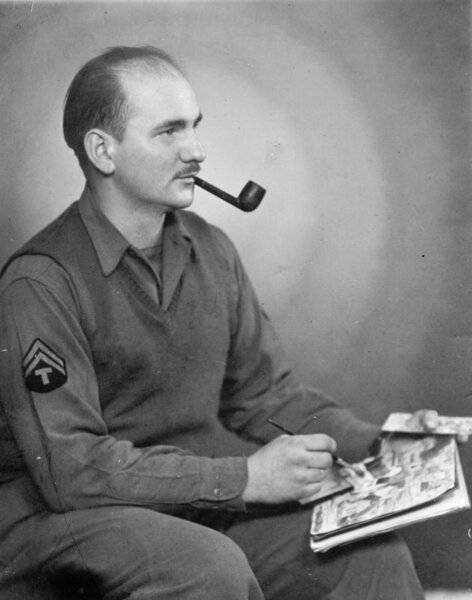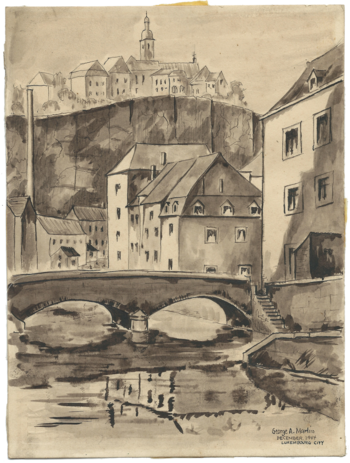George Andrew Martin

T/5 in 603rd Engineer Camouflage Bn : Co B, 4th Platoon
ASN#12183125
Born 1916 in NY, Died 2007
Artist
County of residence at enlistment: New York County, NY
Other residence(s): New York, NY in 1950s; Saddle River, NJ; Burke, VA in 2002
United States Army, European Theatre of Operations
Occupation before the war: commercial artists
College education before the war: Art Students League 2 years; McLane Art Institute; NYU (camouflage)
College education after the war: Columbia (art courses)
George Martin was born on May 17, 1916 in the Bronx, the youngest of three children. Both of his parents were immigrants from Bohemia—his mother was Czech and his father was Hungarian.
He graduated from Textile High School in New York City in 1934, took a PG course there in advertising art, and went to work for several years in the advertising department of Hills Brothers Coffee. In 1939 he took a job as an artist and calligrapher at G. Schirmer Music Publishing, where he designed sheet music covers, book jackets, and circulars; painted in oils--marine views, portraits, and landscapes; made illustrations, sketches, and designs for photo offset reproduction; and did layouts for trade magazines. He also did freelance work—including a poster recruiting women for military service.
Prior to the war, he studied at McLane Art Institute and the Art Students League in New York.
George registered for the draft on October 17, 1940. A few months later, on February 21, 1941, he married Elizabeth Lykke in Manhattan. He enlisted on November 5, 1942. He had taken the Camouflage course at NYU and managed to become a member of the 603rd Engineer Camouflage Battalion.

At the end of the war, he was the designer of the "Routes and Operations Map" of the Ghost Army, with help from some of his fellow soldiers. (A reproduction of the map can be seen in The Ghost Army of World War II.) After he returned to the US, he was given a pass to New York to get the map printed at the printing plan of his pre-war employer, G. Schirmer; a copy was distributed to each of the men as a memento of his wartime experience.
After his discharge, on October 20, 1945, with the rank of T/5, he returned to G. Schirmer and his career as an artist and illustrator. Over the years he created thousands of sheet music covers and record jackets, and illustrated several children's books. In addition to his work for G. Schirmer, he also did illustrations for Fox and Chapel music publishers, among others.
He also took art courses at Columbia after the war—taking every course he could from artist Dong Kingman. They became friends, and, according to George's stepson, Roy Eichhorn, Kingman had a significant impact on George's painting style.
George and Elizabeth lived in Tuckahoe, NY during their marriage. Elizabeth died in 1965, and George would go on to marry Sidonie Wettengel on Valentine's Day, 1969. He and Elizabeth had no children of their own, but Sidonie's three sons—Walter, Peter, and Roy—became his stepsons. He moved to Saddle River, NJ after the marriage, and would live there for nearly 30 years.
George's stepson, Roy Eichhorn, says that his father never spoke about operations or specific details of what the Ghost Army did until after the Smithsonian Magazine article was published in 1985. Even then, he wouldn't answer specific questions until the mid-1990s, when Roy started uncovering documents from the Army and the National Archives.
In 1998, George and Sidonie moved to Burke, VA. Sidonie died in 2000, and George followed her on November 3, 2007. He is buried at Arlington National Cemetery.
A Note About Roy Eichhorn
George's stepson, Roy Eichhorn would go on to become a professor of leadership and management at the Army Management Staff College at Fort Belvoir, VA where he taught for 15 years. He then spent six years as director of R&D at the US Army Combined Arms Center at Fort Belvoir. He has done extensive research on the Ghost Army and other US military deception efforts, and used the Ghost Army as a case study throughout his teaching career. Roy is also a member of the Ghost Army Legacy Project (GALP) board of directors.
Sources:
1920 census
1940 draft card
1941 marriage record
1942 enlistment record
1962 airplane manifest
1969 marriage record
2007 Social Security death record
2007 Find a Grave record
https://www.findagrave.com/memorial/49256388/george-a-martin
2007 VA death record
2021 (April 21) GALP Veteran Biography Worksheet from stepson Roy Eichhorn.
2021 article in the Santa Fe New Mexican about Roy Eichhorn’s presentation at the New Mexico Military Museum in Santa Fe
santafenewmexican.com/pasatiempo/art/art-artifice-and-the-ghost-ar...